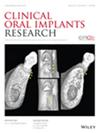Effect of Bone Microstructure Derived From CBCT on the Accuracy of Robot-Assisted Implant Surgery: A Retrospective Study
Abstract
Objective
The aim of this study was to investigate the influence of bone microstructure on the accuracy of robot-assisted dental implant surgery.
Materials and Methods
This retrospective study analyzed 52 patients who received robot-assisted implant surgery between January 2023 and October 2023. Cone beam computed tomography (CBCT) scans were used to evaluate bone microstructural parameters, including the bone volume (BV), tissue volume (TV), bone volume fraction (BV/TV), bone surface (BS), bone surface fraction (BS/BV), trabecular thickness (Tb.Th), and trabecular separation (Tb.Sp). Preoperative and postoperative CBCT data were used to evaluate implant accuracy, and the relationship between bone microstructure parameters and implant deviation including platform deviation, apex deviation, and angular deviation was statistically analyzed.
Results
In robot-assisted implant surgery, BS/BV was a potential facilitator of several implant deviations, while BV/TV and Tb.Th were potential inhibitors of apex global deviation and angular deviation, respectively. Implant deviations were divided into two groups of large and small deviations by median, and the receiver operating characteristic (ROC) curve analysis showed that Tb.Th had the largest area under the ROC for predicting large apex global deviation, 0.711 (p < 0.001), with an optimal cutoff value > 0.179, a sensitivity and specificity of 70.37% and 76.92%.
Conclusion
The study concluded that bone microstructure might affect the accuracy of dental implant placement in robotic surgeries. Incorporating bone quality assessments into preoperative planning may enhance the precision and outcomes of implant procedures, highlighting the potential for further refinement in robotic-assisted dental surgery techniques.
Trial Registration
ClinicalTrials.gov identifier: ChiCTR2400085813


 求助内容:
求助内容: 应助结果提醒方式:
应助结果提醒方式:


